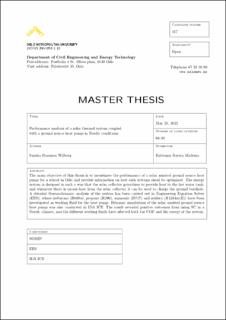| dc.description.abstract | Increased insight into global warming together with the Paris Agreement and the UN climate
report has sparked an interest in renewable energy associated with buildings. Utilizing renewable
energy sources will help reduce the energy consumption in the building sector and minimize the
green house gas emissions. Ground source heat pumps (GSHP) are a frequently used energy
system in Norway today. Since more passive houses have been built in the last years and the
need of efficient energy systems has increased, an increased interest in solar assisted ground
source heat pumps (SGSHP) has been observed. There are however shortcomings in detailed
performance analysis of such systems in a cold climate, and therefore uncertainties if it is
beneficial to implement solar thermal energy to a GSHP.
The main objective of this thesis is to investigate the performance of a SGSHP for a school
building designed according to criteria for passive houses. The performance analysis was then
used to determine if solar thermal energy is suitable for use in a GSHP and how such systems
should be optimized in cold climates. The energy system will provide energy both for domestic
hot water production (DHW) and space heating. The SGSHP is designed in such a way that
the solar collectors (SC) prioritize providing heat to the hot water tank and whenever there is
excess heat from the SC it will be used to charge the ground borehole.
In the thesis, a detailed thermodynamic analysis of the system was carried out in Engineering
Equation Solver (EES). As working fluid for the heat pump (HP) isobutane (R600a), propane
(R290), ammonia (R717) and solstice (R1234ze(E)) have been investigated. Several sensitivity
analyzes were conducted to be able to identify how different parameters influence the
performance of the SGSHP and to provide important knowledge for optimization of the system in a
colder climate.
It was also conducted dynamic simulations in IDA ICE to further investigate how the configuration
of the SGSHP influences the performance. Two separate plants were constructed. In the
first system, the SC was solely used to heat up the water tank, and in the second system the
SC was only connected to the ground heat exchanger (GHX) to recharge the ground. One year
energy simulations were performed to investigate the energy distribution from the systems, and
the soil temperature in the boreholes was plotted over a seven year period.
The main results of the thermodynamic analysis and the dynamic simulations were as follows:
• Recharging the ground with SC will increase the Coefficient of Performance (COP) of the
HP and maintain a thermal stable soil.
• Heating the hot water tank with solar thermal energy will reduce the need for delivered
energy.
• R717 was found to achieve the best COP and lowest exergy destruction in the HP.
• The compressor stood for a significant part of the HP’s exergy destruction, and it was
discovered that subcooling the refrigerant after the condenser reduced this amount.
The investigated SGSHP appeared to be a well-suited approach for heating passive houses in
cold climates. Implementing SC can help a GSHP become more efficient, increase its lifetime
and reduce the over all need for delivered energy to a building. | en_US |
